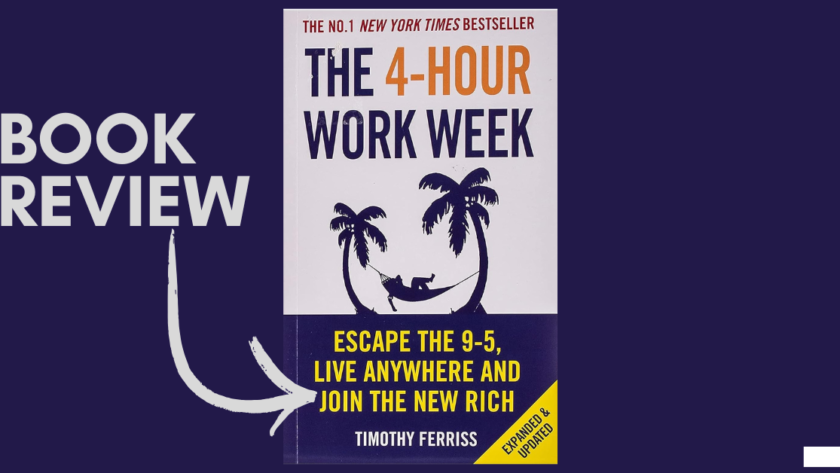I remember the day I first picked up Tim Ferriss’s “The 4-Hour Work Week.” I was skeptical, yet intrigued. As I dove into it’s pages, I found myself both inspired and challenged by Ferriss’s unconventional ideas.
Now, years later, I’m here to offer a balanced review of this influential work that has sparked countless debates and transformed many lives.
Just a heads-up: This post contains affiliate links, which means if you click and make a purchase, I may earn a small commission—at no extra cost to you. I only recommend books and resources I genuinely believe can help you rethink productivity and lifestyle design.
Now, let’s dive into why The 4-Hour Workweek by Tim Ferriss is a game-changer!
Core Concepts of “The 4-Hour Work Week”
Ferriss’s approach to lifestyle design revolves around four key principles:
Definition
The first step in Ferriss’s framework involves clearly articulating your goals and confronting your fears. This process helps you define what you truly want and identify the obstacles holding you back.
To put this into practice, I spent a week writing down my ideal lifestyle in vivid detail. I then listed all the reasons I thought it wasn’t possible.
This exercise was eye-opening, revealing that many of my perceived limitations were self-imposed.
Elimination
Ferriss advocates ruthlessly cutting out unnecessary tasks and distractions. This principle aims to increase productivity by focusing only on essential activities.
When I applied this to my own life, I was shocked to find out about how much time I wasted on low-value tasks. I started by eliminating unnecessary meetings and limiting my email checking to twice a day.
The result?
A significant boost in my productivity and mental clarity.
Automation
Setting up systems to handle repetitive tasks and generate passive income is a crucial aspect of Ferriss’s philosophy. This step frees up time for high-value activities and personal pursuits.
Implementing automation took some trial and error. I started with small tasks like using email filters and auto-responders.
As I grew more comfortable, I explored more advanced automation tools for my business processes.
Liberation
The final step involves breaking free from traditional work constraints and embracing a location-independent lifestyle. This concept challenges conventional notions of work and success.
For me, liberation meant negotiating a remote work arrangement with my employer. While it wasn’t a full 4-hour workweek, it gave me the flexibility to travel and pursue personal projects alongside my career.
The 80/20 Principle: Maximizing Output with Minimal Input
One of the key concepts Ferriss emphasizes is the Pareto Principle, also known as the 80/20 rule. This principle suggests that 80% of our results come from 20% of our efforts.
Applying this principle to my work was transformative. I analyzed my client list and realized that indeed, a small percentage of clients generated the majority of my income.
By focusing more attention on these high-value relationships, I was able to increase my revenue while actually reducing my overall workload.
However, keep in mind that identifying your crucial 20% often needs careful analysis and may not be immediately obvious. I spent several weeks tracking my activities and their outcomes before I could confidently pinpoint my most productive efforts.
Outsourcing and Virtual Assistants: Leveraging Global Talent
Ferriss strongly advocates for extensive use of outsourcing and virtual assistants to free up time for high-value activities. While this approach can be incredibly powerful, it comes with it’s own set of challenges.
My first attempts at outsourcing were frustrating. I made the mistake of delegating tasks without clear instructions, leading to subpar results and wasted time.
Over time, I learned to create detailed process documents and to start with small, low-risk tasks before moving on to more critical responsibilities.
One particularly successful outsourcing experience involved hiring a virtual assistant to handle my email inbox. After a few weeks of training and refining our process, my VA was successfully managing 80% of my emails, freeing up hours of my time each week.
However, it’s crucial to remember that effective outsourcing needs good management skills. You need to be clear in your communication, set realistic expectations, and be prepared to invest time in training and quality control.
Income Automation: Creating Your “Muse”
A central tenet of the 4-Hour Work Week is the creation of automated income streams, which Ferriss calls “muses.” These are typically online businesses designed to generate passive income with minimal ongoing effort.
Inspired by this concept, I decided to create an online course based on my professional expertise. The process of creating the course was time-intensive, requiring several months of work.
However, once launched, it began generating a steady stream of passive income.
Remember that while the idea of passive income is appealing, setting up a successful muse often needs significant upfront work and ongoing maintenance.
While many readers have found success with this approach, keep in mind it’s not a guaranteed path to easy riches.
My experience taught me that creating a successful muse business requires:
- Identifying a viable market niche
- Developing a product or service that solves a real problem
- Creating effective marketing systems
- Continuously improving and updating your offering
While my online course hasn’t allowed me to quit my day job, it has provided a valuable additional income stream and opened up new opportunities in my field.
Geoarbitrage: Maximizing Your Purchasing Power
Ferriss introduces the concept of geoarbitrage – earning in a strong currency while living in a country with a lower cost of living. This strategy can dramatically increase your effective income and quality of life.
I experimented with geoarbitrage by spending six months working remotely from Southeast Asia. The experience was eye-opening.
My cost of living dropped significantly, allowing me to save money while enjoying a high quality of life.
However, it’s crucial to consider the potential downsides of this approach:
- Cultural adjustment can be challenging
- Language barriers may impact your daily life and work
- Being away from home can strain personal relationships
- Long-term career prospects might be affected if you’re absent from your home market for extended periods
I’ve seen friends thrive as digital nomads, fully embracing the geoarbitrage lifestyle. Others struggled with isolation and eventually returned home.
The success of this strategy largely depends on your personal adaptability and the nature of your work.
Mini-Retirements: Redefining Work-Life Balance
Instead of deferring enjoyment until traditional retirement age, Ferriss advocates for taking periodic “mini-retirements” throughout your working life.
This approach allows you to enjoy extended periods of travel or personal pursuits while you’re still young and healthy.
Implementing mini-retirements needs careful planning and often a shift in mindset. It may involve negotiating with your employer for extended leave or structuring your business to allow for prolonged absences.
I took my first mini-retirement two years after reading Ferriss’s book. I spent three months traveling through South America, learning Spanish, and volunteering.
The experience was incredibly rewarding, providing me with new perspectives and rejuvenating my passion for my work.
However, planning for this mini-retirement was challenging. It involved:
- Saving money to cover expenses during my time off
- Negotiating an extended leave with my employer
- Setting up systems to manage my side business while I was away
- Mentally preparing for a break from my routine and career progression
While the concept of mini-retirements is appealing, it’s not possible for everyone. It needs financial stability, a supportive work environment or a flexible career, and the ability to disconnect from your regular life for extended periods.
Ready to redefine work-life balance? Grab your copy of The 4-Hour Workweek and start planning your first mini-retirement!
Common Pitfalls and How to Avoid Them
Unrealistic Expectations
Many readers of “The 4-Hour Work Week” expect to achieve a dramatically reduced workweek overnight. This unrealistic expectation can lead to frustration and disappointment.
Instead, focus on gradually reducing your hours and increasing your efficiency. Start by identifying your most time-consuming tasks and look for ways to streamline or eliminate them.
Set realistic goals for reducing your work hours over time.
Neglecting Skill Development
While automation and outsourcing are powerful tools, relying on them exclusively can lead to a dangerous atrophy of your skills. Continuous learning and growth are essential to maintain your value in the marketplace.
I make it a point to dedicate time each week to learning new skills related to my field. This keeps me competitive and allows me to take on higher-value work, further increasing my earning potential.
Isolation
The lifestyle Ferriss advocates can sometimes lead to social isolation, especially if you’re working remotely or traveling often. Make a conscious effort to build and maintain relationships, both personal and professional.
During my experiment with remote work, I found it helpful to:
- Join local coworking spaces
- Attend networking events in my industry
- Schedule regular video calls with friends and family
- Participate in online communities related to my work and interests
Adapting the 4-Hour Work Week to Your Reality
While Ferriss’s ideas are compelling, they may not be fully applicable to everyone’s situation. Here are some ways to adapt the principles to your life:
Start Small
Begin by identifying and eliminating your biggest time-wasters. Even small improvements in efficiency can have a significant impact on your productivity and work-life balance.
I started by tracking my time for a week, then identifying activities that weren’t contributing to my goals. Simply cutting out unnecessary meetings and limiting social media use freed up several hours each week.
Negotiate Flexibility
If you’re not ready to leave your job, try negotiating for more flexible hours or remote work options. Many employers are becoming more open to flexible work arrangements, especially in the wake of the global pandemic.
I approached my boss with a proposal for a trial period of working remotely two days a week. By demonstrating increased productivity during this trial, I was able to secure a permanent flexible work arrangement.
Side Hustle
Start a small side business to test the waters of entrepreneurship and passive income. This allows you to experiment with Ferriss’s principles without the risk of quitting your day job.
My online course started as a side project, allowing me to learn about online business and passive income streams while maintaining the security of my full-time job.
Mindset Shift
Even if you can’t dramatically reduce your work hours, adopt the mindset of the “New Rich” by prioritizing experiences and personal growth over material possessions.
This shift in perspective has been one of the most valuable takeaways from Ferriss’s book for me. By focusing on experiences as opposed to possessions, I’ve found greater satisfaction and fulfillment in both my personal and professional life.
Exercises to Implement 4-Hour Work Week Principles
Time Audit
Track your activities for a week to identify where your time is really going. Use a spreadsheet or a time-tracking app to log your activities in 30-minute increments.
At the end of the week, analyze your data. Look for patterns, time-wasters, and activities that could be eliminated, automated, or outsourced.
80/20 Analysis
List your top 10 activities in work and life, then identify which 20% are producing 80% of your desired results. This exercise can be eye-opening, revealing where you should focus your efforts for most impact.
For example, when I did this exercise, I realized that two of my clients were responsible for the majority of my income. This led me to restructure my business to focus more on high-value clients and projects.
Fear-Setting
Write down your biggest fears about making life changes, then plan how you would mitigate or recover from worst-case scenarios. This exercise, developed by Ferriss, helps overcome the paralysis that often prevents us from taking action.
When I was considering taking my mini-retirement, I wrote down all my fears: running out of money, falling behind in my career, losing clients. By addressing each fear and creating contingency plans, I felt more confident in my decision to take the leap.
Dreamlining
Create a detailed vision of your ideal lifestyle, including specific, measurable goals for 3, 6, and 12 months out. This exercise helps clarify your priorities and gives you concrete targets to work towards.
My first dreamline included goals like “work remotely for one month from Bali” and “launch an online course with 100 students.” Having these specific, time-bound goals motivated me to take action and make changes in my life.
Frequently Asked Questions
What is the 4-Hour Work Week?
The 4-Hour Work Week is a book by Tim Ferriss that outlines strategies for increasing productivity, automating income, and designing a lifestyle that prioritizes freedom and flexibility over traditional notions of work and success.
Can anyone really work only 4 hours a week?
While a literal 4-hour workweek is not realistic for most people, the principles in the book can help significantly reduce work hours and increase productivity for many people.
How do I start implementing the 4-Hour Work Week principles?
Begin by conducting a time audit to identify where you’re spending your time, then focus on eliminating, automating, or outsourcing low-value tasks. Start small and gradually work towards more significant changes.
What is a “muse” business?
A muse business, as described by Ferriss, is a low-maintenance business designed to generate passive income with minimal ongoing effort. Examples include dropshipping, information products, or software as a service (SaaS) businesses.
How can I convince my employer to let me work remotely?
Start by proposing a trial period of remote work, demonstrating how it can benefit both you and the company. Present a clear plan for communication and productivity measurement during the trial.
What are some common mistakes people make when trying to apply the 4-Hour Work Week?
Common mistakes include expecting immediate results, neglecting skill development, and becoming socially isolated. It’s important to approach the principles realistically and maintain a balance in your life.
How can I create passive income streams?
Passive income streams can be created through various methods, such as creating and selling digital products, investing in dividend-paying stocks, or starting an e-commerce business with automated fulfillment.
What is geoarbitrage and how can I use it?
Geoarbitrage involves earning money in a strong currency while living in a location with a lower cost of living. This can be achieved through remote work arrangements or by running location-independent businesses.
How do I overcome the fear of making big life changes?
Ferriss recommends using the “fear-setting” exercise to identify and address your fears. By planning for worst-case scenarios, you can often realize that the risks are manageable and the potential rewards outweigh the risks.
Can the 4-Hour Work Week principles be applied to traditional employment?
While some principles may be more challenging to apply in traditional employment, many concepts like increasing productivity, negotiating for flexibility, and prioritizing high-value tasks can be useful in any work setting.
Key Takeaways
- The 4-Hour Work Week offers a provocative alternative to traditional work-life paradigms.
- Efficiency and effectiveness are more important than hours worked.
- Outsourcing and automation can free up time for high-value activities.
- Lifestyle design needs intentional planning and ongoing adjustment.
- The principles can be adapted to various life situations, even if a literal 4-hour workweek isn’t possible.




